Elbow Sprain
Table of Contents
Description
An elbow sprain refers to the stretching or tearing of the ligaments in the elbow joint due to excessive force or overextension. This can result in pain, swelling, and reduced flexibility in the affected area. The severity of an elbow sprain can range from mild to severe, depending on the extent of ligament damage.
Anatomy of Elbow Joint
An elbow sprain involves the ligaments of the elbow joint. Ligaments are tough, fibrous tissues that connect bones to each other, providing stability to the joint. In the case of an elbow sprain, the ligaments that are most commonly affected include:
Medial Collateral Ligament (MCL): This ligament is on the inner side of the elbow and helps stabilize the joint from side-to-side movements.
Lateral Collateral Ligament (LCL): Found on the outer side of the elbow, the LCL also contributes to stability and prevents excessive sideways motion.
Annular Ligament: This ligament encircles the radial head, helping to hold it securely in the joint.
Elbow sprains can range from mild, where the ligaments are slightly stretched, to severe, involving partial or complete tears of the ligaments. The injury can cause pain, swelling, bruising, and limited range of motion. Treatment varies based on the severity, and it typically involves rest, ice, compression, and elevation (RICE), along with physical therapy and sometimes immobilization. Severe cases might require surgical intervention.
Epidemiology of Elbow Sprain
Elbow sprains are relatively common injuries, especially among individuals who engage in sports or activities that involve repetitive arm movements, impact, or forceful twisting motions. While exact statistics can vary, here are some general points about the epidemiology of elbow sprains:
Sports and Activities: Elbow sprains are often seen in sports like baseball, tennis, golf, and contact sports. Athletes who participate in throwing, swinging, or weightlifting are particularly prone to these injuries.
Age and Gender: Elbow sprains can affect individuals of all ages, but they are more common in young adults and athletes due to their higher activity levels. Both males and females can experience elbow sprains, though the prevalence might vary based on the specific sports and activities they engage in.
Prevalence: Elbow sprains are a common reason for seeking medical attention. They can occur in isolation or as part of more complex injuries involving the elbow joint, such as dislocations or fractures.
Risk Factors: Risk factors for elbow sprains include inadequate warm-up, poor technique during sports, overuse, sudden impact, and lack of conditioning or flexibility.
Seasonal Variation: Elbow sprains might have some seasonal variation, with an increased occurrence during times of the year when certain sports are more popular or when outdoor activities are common.
It’s important to note that these points provide a general overview, and the specific epidemiology of elbow sprains can vary based on geographical location, demographics, and cultural factors.
Causes of Elbow Sprain
Elbow sprains are typically caused by the excessive stretching or tearing of the ligaments that support the elbow joint. Some common causes include:
Forceful Impact: Direct impact to the elbow, such as falling onto an outstretched arm, can strain or tear the ligaments.
Repetitive Motion: Repeatedly performing certain arm movements, like throwing or swinging, especially without proper technique or conditioning, can lead to overuse and eventual sprains.
Sudden Twisting: Abrupt twisting or hyperextension of the elbow beyond its normal range of motion can injure the ligaments.
Contact Sports: Participation in contact sports like football, rugby, or martial arts increases the risk of elbow sprains due to the physical nature of these activities.
Overexertion: Excessive force or strain placed on the elbow joint, often seen in weightlifting or heavy lifting, can lead to ligament injuries.
Improper Technique: Using improper form during exercises or activities can stress the ligaments and increase the risk of sprains.
Inadequate Warm-up: Failing to warm up properly before engaging in physical activities can leave the ligaments more susceptible to injury.
Poor Conditioning: Insufficient strength, flexibility, or conditioning of the muscles around the elbow can contribute to increased stress on the ligaments.
Previous Injuries: If there’s a history of previous elbow injuries, the ligaments might be weakened, making them more prone to sprains.
It’s important to take preventive measures, such as using proper technique, warming up, and gradually increasing activity levels, to reduce the risk of elbow sprains. If an injury does occur, seeking medical attention and following proper rehabilitation guidelines are crucial for a successful recovery.
Symptoms of Elbow Sprain
The symptoms of an elbow sprain can vary in intensity depending on the severity of the injury. Common symptoms include:
Elbow Pain: Pain around the elbow joint is a hallmark symptom. The pain might be sharp, dull, or throbbing, and it can range from mild to severe.
Swelling: Swelling around the elbow area due to inflammation of the ligaments is common.
Bruising: Bruising or discoloration might develop around the injured area, particularly if blood vessels are also affected.
Stiffness: The elbow might feel stiff and difficult to move due to the swelling and pain.
Limited Range of Motion: Difficulty in fully extending or bending the elbow is often experienced.
Tenderness: The area around the injured ligaments may be tender to the touch.
Weakness: Weakened grip strength and reduced ability to perform everyday tasks can occur.
Instability: A feeling of instability or a “loose” sensation in the elbow might be present.
Popping or Clicking: Some individuals might notice popping, clicking, or snapping sensations when moving the elbow.
It’s important to note that symptoms can vary from person to person and depend on the specific ligaments that are affected and the severity of the sprain. If you suspect an elbow sprain, especially if the pain is severe or if there’s significant difficulty moving the joint, it’s advisable to seek medical attention for proper diagnosis and treatment.
Differential diagnosis of elbow sprain
Several conditions and injuries can present with symptoms similar to those of an elbow sprain. A few potential differential diagnoses include:
Elbow Fracture: Fractures of the bones in the elbow, such as the radius or ulna, can cause pain, swelling, and limited range of motion similar to an elbow sprain.
Tendonitis: Inflammation of the tendons in the elbow (e.g., tennis elbow or golfer’s elbow) can result in pain and discomfort that may mimic a sprain.
Elbow Dislocation: An elbow dislocation occurs when the bones of the joint are forced out of alignment, causing severe pain and noticeable deformity.
Nerve Compression: Conditions like cubital tunnel syndrome, which involves compression of the ulnar nerve, can lead to pain and tingling sensations in the elbow area.
Bursitis: Inflammation of the bursa sac, which cushions the joint, can cause swelling and discomfort around the elbow.
Radial Head Subluxation: Also known as “nursemaid’s elbow,” this occurs when the radius bone slips out of its normal position in the elbow joint.
Joint Arthritis: Arthritis can cause chronic pain, stiffness, and limited movement in the elbow.
Muscle Strain: Straining the muscles around the elbow due to overuse or trauma can produce pain and discomfort.
Ligament Tears: Severe ligament tears might require differentiation from a sprain and may involve more extensive diagnostic measures.
Given the potential overlap in symptoms, it’s important to consult a medical professional for an accurate diagnosis. They will typically conduct a physical examination, consider your medical history, and possibly order imaging tests (such as X-rays or MRI) to determine the exact cause of your symptoms and provide appropriate treatment.
Diagnosis
The diagnosis of an elbow sprain typically involves a combination of medical history assessment, physical examination, and sometimes imaging studies. Here’s how the diagnosis process is generally done:
Medical History: The doctor will ask you about the circumstances leading up to your injury, the specific symptoms you’re experiencing, and any relevant medical history.
Physical Examination: The doctor will physically examine your elbow, checking for tenderness, swelling, bruising, and range of motion. They might manipulate your arm to assess stability and identify any potential ligament damage.
Range of Motion Test: You may be asked to move your elbow in different directions to evaluate the extent of your range of motion and to determine if any motions are particularly painful or restricted.
Imaging Studies: In some cases, imaging studies might be ordered to confirm the diagnosis and assess the severity of the injury. X-rays can help rule out fractures, while MRI (Magnetic Resonance Imaging) can provide detailed images of soft tissues like ligaments.
Stress Testing: If the doctor suspects ligament damage, they might perform stress tests to assess the stability of the joint. This involves applying pressure in specific directions to test the integrity of the ligaments.
Comparative Assessment: The doctor might compare the injured elbow to the uninjured one to identify differences in range of motion, stability, and symptoms.
Rule Out Other Conditions: As mentioned earlier, the doctor will also consider other potential conditions that could mimic the symptoms of an elbow sprain and will work to rule those out.
Based on the findings from these steps, the doctor can determine the severity of the elbow sprain and recommend appropriate treatment, which could range from conservative measures like rest and physical therapy for mild sprains to more intensive treatments like immobilization or even surgical intervention for severe cases.
Treatment of Elbow Sprain
The medical treatment of an elbow sprain depends on the severity of the injury. Here are some common approaches:
Rest and Immobilization:
For mild to moderate sprains, the initial treatment often involves rest to allow the ligaments to heal. Immobilization with a splint, brace, or sling may be recommended to prevent further strain on the injured area.
Ice:
Applying ice to the affected area can help reduce swelling and ease pain. Ice should be applied for about 15-20 minutes every few hours during the initial 48 hours after the injury.
Pain Relief:
Over-the-counter pain medications like acetaminophen or nonsteroidal anti-inflammatory drugs (NSAIDs) can help manage pain and reduce inflammation.
Compression:
Wrapping the elbow with an elastic bandage can help control swelling, but it’s important not to wrap it too tightly to avoid compromising blood flow.
Elevation:
Keeping the injured arm elevated can further assist in reducing swelling.
Physical Therapy:
Once pain and swelling start to subside, physical therapy exercises can help restore strength, flexibility, and range of motion to the elbow joint.
Corticosteroid Injections:
In some cases, a doctor might administer corticosteroid injections to reduce inflammation and provide pain relief. These are typically considered for more severe cases.
Surgery:
Severe cases of ligament tears might require surgical intervention, especially if conservative methods aren’t effective. Surgery desires to repair or reconstruct the injured ligaments.
Surgical methods for treating severe elbow sprains usually involve repairing or reconstructing the damaged ligaments. The specific surgical approach depends on the severity and location of the sprain. Here are some common surgical methods:
Ligament Repair: In cases where the ligament is partially torn but still has good tissue quality, the surgeon might opt to repair it. This involves suturing the torn ends of the ligament back together.
Ligament Reconstruction: If the ligament is severely torn or if the tissue quality is poor, a reconstruction might be necessary. During reconstruction, the surgeon might use grafts (tendon tissue from elsewhere in the body or a donor) to replace the damaged ligament.
Tommy John Surgery (Ulnar Collateral Ligament Reconstruction): This procedure is commonly associated with baseball players. It involves using a tendon graft, often from the forearm or hamstring, to reconstruct the ulnar collateral ligament (UCL) of the elbow.
Open Surgery vs. Arthroscopic Surgery: Some procedures can be done using minimally invasive techniques (arthroscopy), where small incisions and a camera are used. Others may require larger incisions (open surgery) to access and repair the ligaments.
Reattachment of Tendon to Bone: In some cases, the ligament or tendon might have pulled away from the bone. Surgical methods involve reattaching the tendon or ligament to its proper location on the bone.
Rehabilitation and Recovery: After surgery, a comprehensive rehabilitation program is crucial. Physical therapy helps regain strength, range of motion, and function in the elbow joint.
Gradual Return to Activities: As the elbow heals, a gradual return to activities and sports is recommended. This should be done under the guidance of a medical professional to avoid re-injury.
It’s crucial to consult a healthcare provider for proper diagnosis and treatment recommendations. They can tailor the treatment plan to your specific injury and needs, helping you recover effectively and prevent long-term complications.
Physiotherapy treatment of Elbow Sprain
Physiotherapy plays a crucial role in the recovery process for elbow sprains. A physiotherapist will design a personalized treatment plan based on the severity of the sprain and your individual needs. Here’s how physiotherapy can help:
Pain and Inflammation Management:
Physiotherapists may use techniques like ice, heat, ultrasound, and electrical stimulation to manage pain and reduce inflammation in the early stages of recovery.
Range of Motion Exercises:
Gentle exercises help maintain and gradually improve the range of motion in the elbow joint. These exercises prevent stiffness and encourage healing.
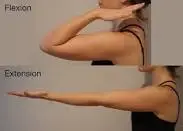
Elbow Flexion
Elbow flexion refers to the ability to flex the elbow. To enhance the elbow flexion ROM:
- Start with standing with the arm at the side.
- Actively flex the elbow up as far as possible, then grasp the forearm or wrist with the other hand and gently add pressure.
- Maintain the flex position of the elbow for 5 to 10 seconds, and then release the stretch by straightening the elbow.
- Repeat the exercise 5 to 10 times.
Elbow Extension
To improve the ability to fully straighten the elbow, a person must work on elbow extension ROM exercises. To do this:
- Begin with sitting in a chair with the elbow resting on a table. A person can want to rest the upper arm on a pillow or folded towel for comfort.
- Extend the elbow out all the way, and then give pressure to the forearm or wrist to add extra pressure to the stretch.
- Straighten the elbow out as far as a person may with overpressure, and maintain the stretch for five to 20 seconds.
- Release the stretch and permit the elbow to flex a bit.
- Repeat the exercise for 10 repetitions.
- A person may also add a bit of stretch to the elbow extension by holding onto a 2- to 3-pound weight.
Forearm Supination
The ability to turn the wrist over so the hand faces up is called supination, and this motion arises at both the elbow and the wrist joint. To enhance the capability to supinate the hand, perform the forearm supination ROM exercise.
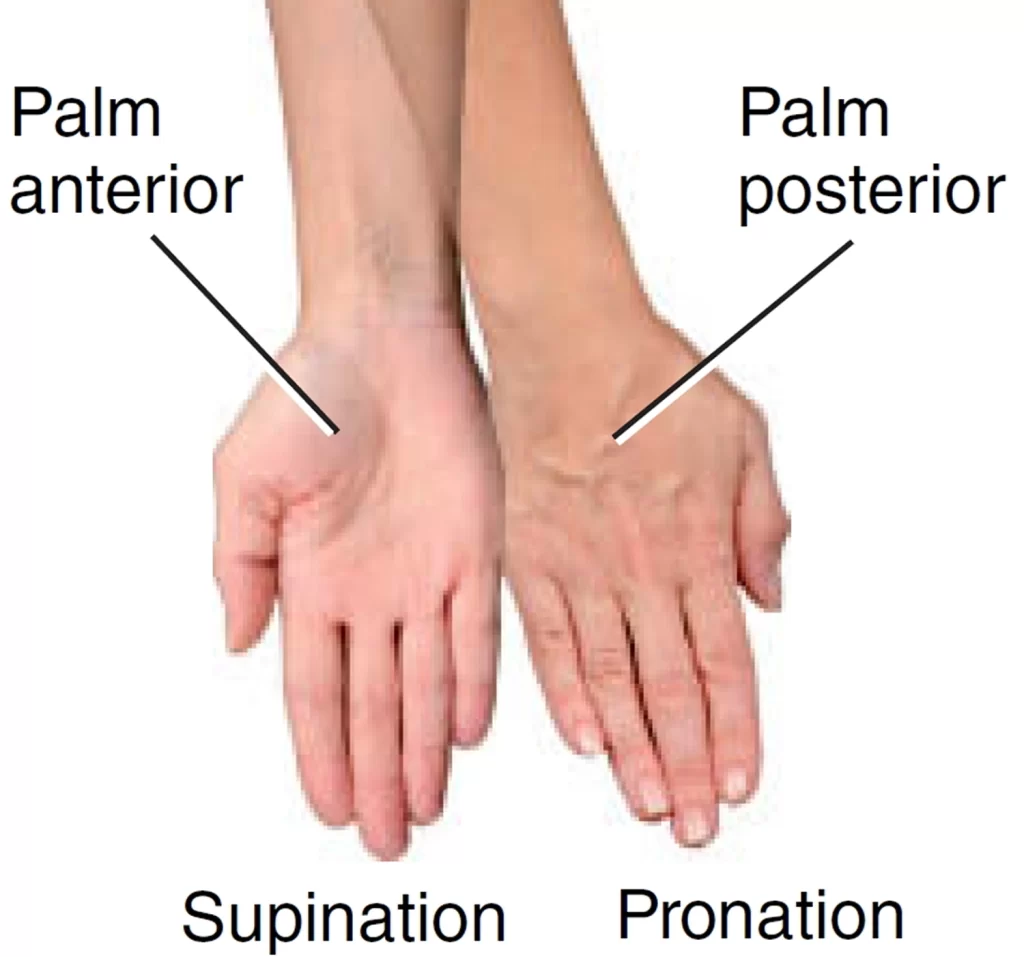
To do the exercise:
- Start with a Stand or sit with the arm at the side and the elbow bent about 90 degrees.
- Hold the elbow at the side and turn the wrist and hand over so the palm faces up.
- Reach below the supinated arm’s forearm with the opposite hand to increase the stretch’s overpressure.
- Grab the wrist and gently add overpressure by turning the hand further into supination.
- When a stretch is sensed, maintain the position for five to 10 seconds.
- Repeat elbow supination ROM for 10 repetitions.
Forearm and Elbow Pronation
Forearm pronation guides the ability to turn the hand over so the palm faces the floor. This motion is essential in performing tasks like pouring a cup of coffee or playing the piano.
To do the forearm pronation ROM stretch:
- Start with a Stand or sit with the elbow bent 90 degrees and tucked in at the side.
- Turn the hand and wrist over as far as possible, then reach the other hand over the top of the forearm.
- Take the wrist, and turn the arm further into a pronated position.
- Maintain the position with overpressure for five to 10 seconds, and then release the stretch.
- Repeat the pronation ROM stretch 10 times.
Strengthening Exercises:
Gradually introducing strengthening exercises helps rebuild the muscles around the elbow. This provides stability to the joint and supports the healing ligaments.
Wrist and Elbow Strengthening and Stretching Exercises
Resisted Wrist Flexion
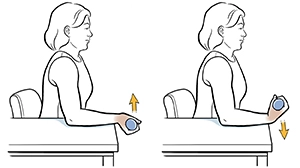
- With tubing wrapped around the hand and the opposite end secured under the foot, keep the palm facing up and bend the wrist and hand upward as far as you can.
- Maintain 1 count and lower gradually 3 counts.
- This movement may also be done with a dumbbell.
Resisted Wrist Extension

- With tubing wrapped around the hand and the opposing end secured under the foot, hold the palm facing down and flex the wrist and hand upward as far as you may.
- This exercise may also be done with a dumbbell.
Resisted Forearm Supination and Pronation
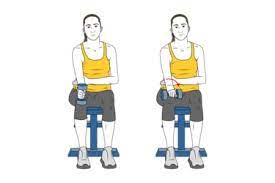
- Keeping a dumbbell, with the forearm supported on your thigh, gradually turn the palm facing up and then gradually turn the palm facing down.
- Be sure to hold the elbow still and only move the forearm.
Wrist Flexor Stretch
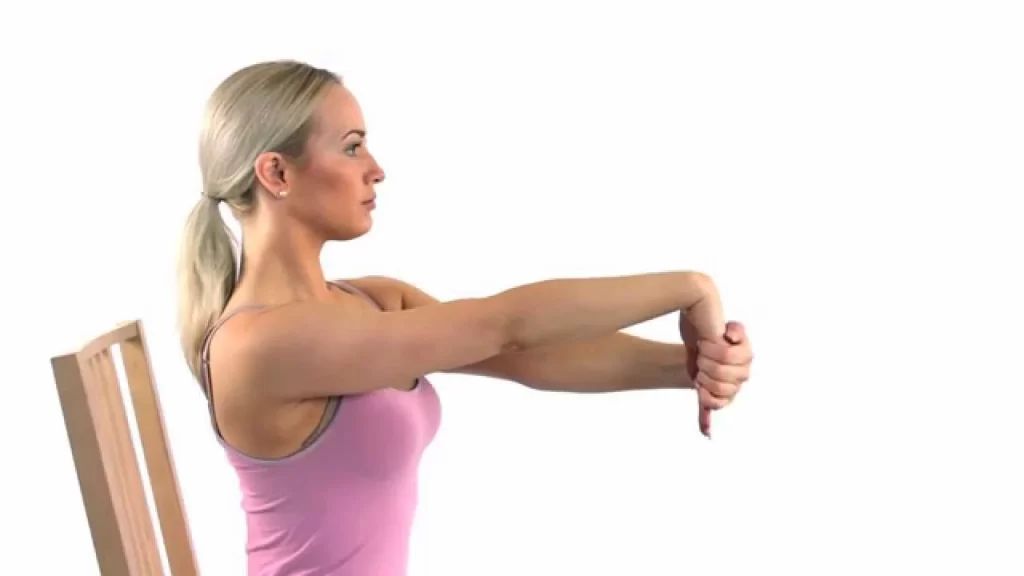
- Keep the arm with the elbow straight and the palm facing up.
- Grasp the involved hand at the fingers and stretch the wrist backward, until A stretch is felt on the inside of the forearm.
Wrist Extensor Stretch

- Keep the arm with the elbow straight and the palm facing down.
- Press downward on the back of the involved hand until a stretch is felt in the muscles on the outside of the forearm.
Biceps Curl
- Start with a Stand or sit on a bench or chair. With the palm facing forward and the elbow against the side, raise the weight up toward the shoulder.
- Maintain the elbow firmly against the side and lower the weight back to the starting position.
Triceps Extensions
- Start with lying on the back on a weight bench. Maintain a dumbbell starting with the elbow straight.
- Maintain the upper arm vertically while gradually bending the elbow toward the forehead. Gradually back to the upright position.
Flexibility and Stretching:
Specific stretches may enhance flexibility, ensuring that scar tissue doesn’t restrict the joint’s movement.
Manual Therapy:
Physiotherapists might use hands-on techniques like joint mobilizations and soft tissue massage to improve circulation, reduce tension, and enhance healing.
Proprioceptive Training:
Proprioception refers to the body’s sense of its position in space. Training exercises help improve balance and coordination, which are important for joint stability.
Functional Exercises:
These exercises focus on mimicking daily activities and sports movements to help you regain full functionality of your elbow.
Gradual Return to Activities:
Physiotherapists guide you through a progressive return to your usual activities, ensuring that you’re ready and minimizing the risk of re-injury.
Education:
Physiotherapists educate you about proper body mechanics, ergonomics, and techniques to prevent future injuries.
Home Exercise Program:
A physiotherapist will provide you with exercises to continue at home, facilitating your recovery between sessions.
Remember, the effectiveness of physiotherapy depends on your commitment to the exercises and recommendations provided by the physiotherapist. It’s important to attend sessions regularly, follow their guidance, and communicate any changes or concerns you experience during your recovery journey.
FAQ
How much time does a sprained elbow take to heal?
Mild elbow sprains will ultimately settle after a few weeks. It’s crucial that you stay away from exercising during that time. Up to three months may pass before a more serious sprain heals.
Do elbow sprains heal?
An elbow sprain happens when a person overstretches or tears the ligaments around the elbow. Ligaments are the tough tissues that attach one bone to another. A sprain may occur when a person falls or when you play sports or do chores around the house. Some sprains will heal with some therapy at home.
How do you treat a sprained elbow?
Rest: Restrict and modify everyday activity to permit the ligaments to heal. Ice: Ice the area periodically (every 15-20 minutes) to decrease swelling and prevent tissue damage. Compression: This allows support for the elbow and decreases swelling. The doctor can recommend keeping it wrapped with a tight elastic bandage.
What is a Grade 1 elbow sprain?
A grade 1 sprain indicates that the ligament is stretched but no tear is felt. A grade 2 sprain indicates the ligament is stretched and a partial tear might be present. A grade 3 sprain implies there is a total tear of the ligament.
How long does elbow pain last?
In many cases, new pain or a flare-up of long-standing elbow problems should start to settle within 6 weeks without the requirement to see a healthcare professional.


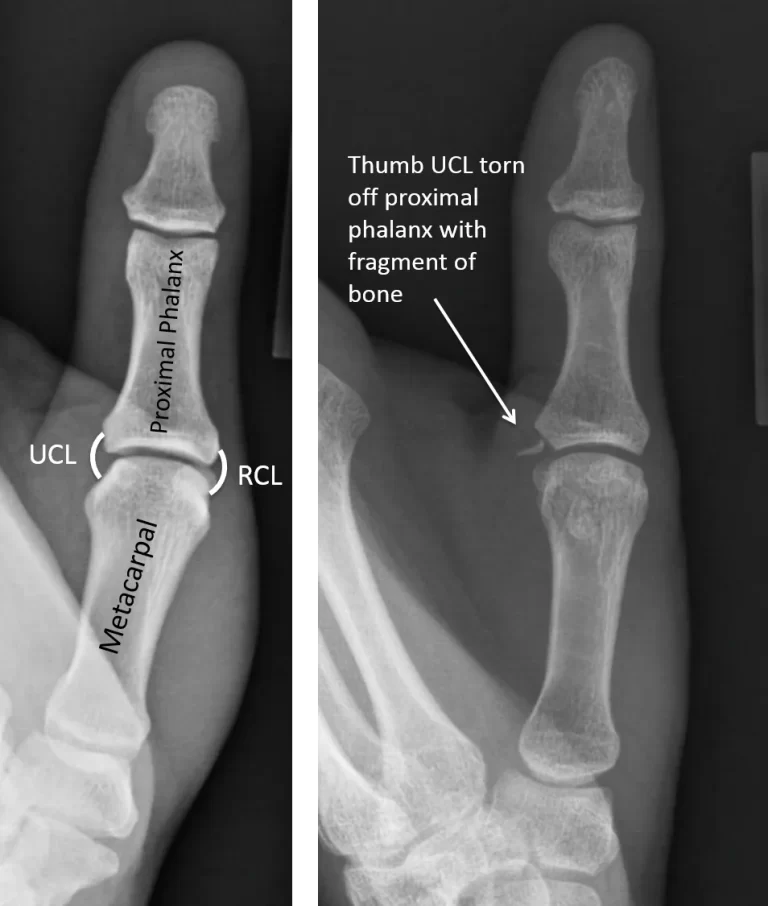
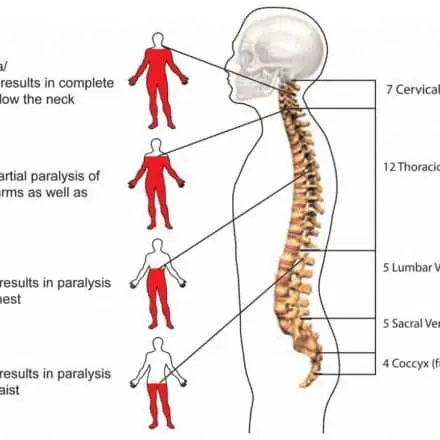
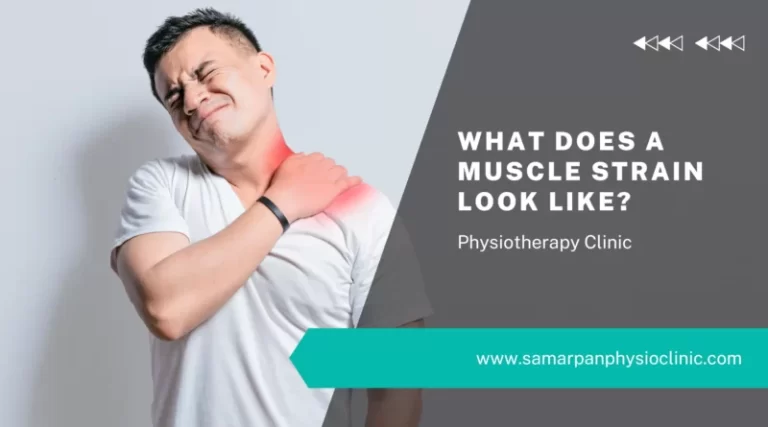
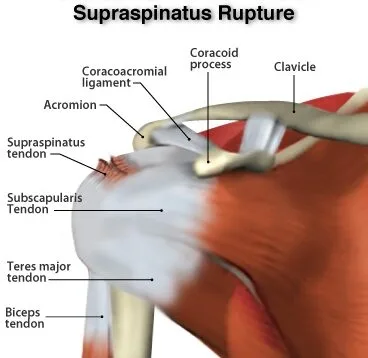
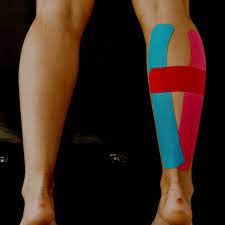
One Comment